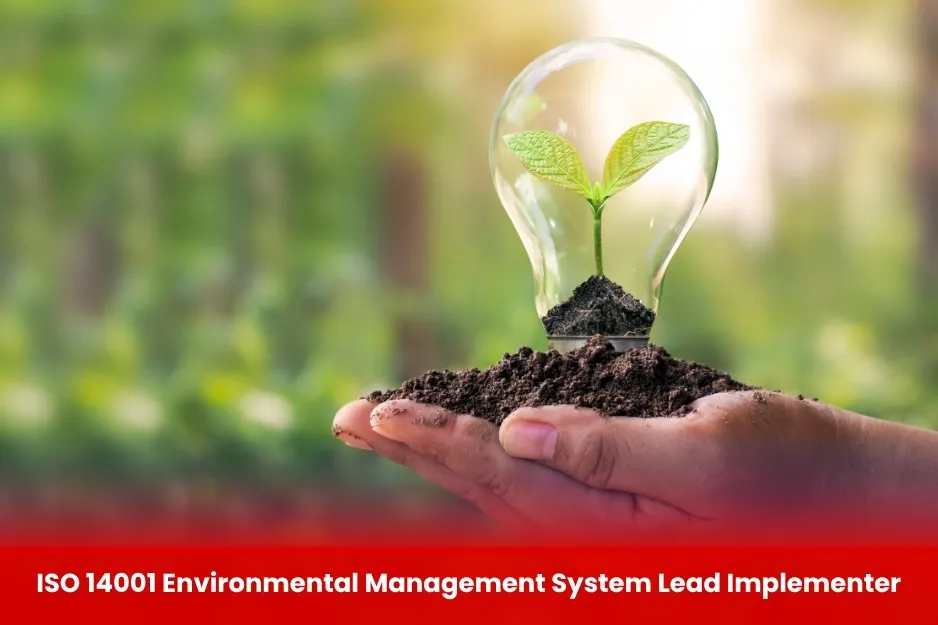ISO 14001 Environmental Management System Lead Implementer
ISO 14001 is the internationally recognized standard for Environmental Management Systems (EMS). It provides organizations with a framework to manage their environmental responsibilities in a systematic and sustainable way.
An ISO 14001 Lead Implementer is a trained professional who leads the planning, development, implementation, and maintenance of an effective EMS aligned with ISO 14001 requirements. This role is crucial for organizations aiming to reduce their environmental impact, comply with legal and regulatory requirements, and improve overall environmental performance.

Aim of ISO 14001 Environmental Management System Lead Implementer
Effectively lead the development, implementation, and maintenance of an Environmental Management System (EMS) that complies with ISO 14001 requirements, enabling the organization to minimize its environmental impact, ensure legal compliance, and drive continual improvement in environmental performance.
Course Overview
ISO 14001 Environmental Management System Lead Implementer
Educational Qualification
- Bachelor’s degree or diploma in Environmental Science, Engineering, Management, Sustainability, or any relevant technical field.
- Candidates from other backgrounds may also apply if they have relevant work experience.
Professional Experience
- 1–3 years of experience in environmental management, sustainability, health & safety, compliance, or related fields.
- Prior involvement in environmental programs, EMS development, audits, or compliance projects is an added advantage.
Knowledge Requirements
- Basic understanding of:
- Environmental issues and legislation
- Sustainability practices
- ISO 14001 standard structure and intent
- Awareness of other management systems (like ISO 9001, ISO 45001) is helpful but not mandatory.
| Course Code | Curriculum Title | Credit | DLH |
|---|---|---|---|
| BUK1965-1 | Introduction to ISO 14001:2015 | 3 | 10 |
| BUK1965-2 | Understanding the Standard Requirements | 3 | 10 |
| BUK1965-3 | Environmental Risk and Aspect Management | 3 | 10 |
| BUK1965-4 | Planning for EMS Implementation | 3 | 10 |
| BUK1965-5 | Implementing the EMS | 3 | 10 |
| BUK1965-6 | Certification and Audit Preparation | 3 | 10 |
Module 1: Introduction to ISO 14001:2015
- verview of ISO and ISO 14001 family of standards
- Purpose, scope, and benefits of Environmental Management Systems
- Structure of ISO 14001:2015 (Annex SL – High-Level Structure)
- Key definitions and terminology
Module 2: Understanding the Standard Requirements
- Clause-by-clause explanation of ISO 14001:2015:
- Context of the Organization
- Leadership and Commitment
- Planning (Environmental Aspects, Legal Requirements, Risks & Opportunities)
- Support (Resources, Competence, Communication, Documented Information)
- Operation (Control, Emergency Preparedness & Response)
- Performance Evaluation (Monitoring, Measurement, Internal Audit)
- Improvement (Nonconformity, Corrective Action, Continual Improvement)
Module 3: Environmental Risk and Aspect Management
- Identifying environmental aspects and impacts
- Evaluating significance
- Legal and regulatory compliance
- Setting objectives and environmental performance indicators
Module 4: Planning for EMS Implementation
- Project planning for EMS development
- Defining scope and boundaries
- Developing policies, procedures, and documentation
- Aligning EMS with organizational strategy
Module 5: Implementing the EMS
- Operational controls and lifecycle perspective
- Emergency preparedness and response
- Competence, training, and awareness programs
- Internal and external communications
Module 6: Monitoring, Measuring & Evaluating Performance
- Environmental performance indicators
- Monitoring methods and frequency
- Nonconformity management
- Internal audit planning and execution
Module 7: Management Review and Continual Improvement
- Conducting effective management reviews
- Using data to drive improvement
- Corrective and preventive actions
- Updating the EMS for effectiveness
Module 8: Certification and Audit Preparation
- Preparing for third-party (certification) audits
- Working with external auditors
- Maintaining compliance post-certification
- Certification bodies and accreditation proces
Module 9: Case Studies and Practical Exercises
- Real-life EMS implementation scenarios
- Group activities, workshops, and role-plays
- Document review and gap analysis exercises
Module 10: Final Assessment and Certification
- Written examination or project evaluation
- Review and feedback
- Certification of completion
- Environmental Managers / Officers / Coordinators
- Sustainability Professionals
- Health, Safety, and Environment (HSE) Professionals
- Compliance and Risk Managers
- Quality and Integrated Management System (IMS) Professionals
- Consultants and Auditors
- Environmental Engineers or Technical Staff
- Aspiring EMS Professionals and Graduates
- All Modules within this qualification are assessed internally by the approved training Centre and externally verified by BURRAQ UK. The program uses a criterion-referenced assessment approach to ensure that learners successfully meet all required learning outcomes.
- A Pass in any unit is granted only when the learner submits valid, reliable, and authentic evidence that demonstrates achievement of the assessment criteria. The Assessor is responsible for reviewing this evidence and confirming that the learner has attained the expected standard.
